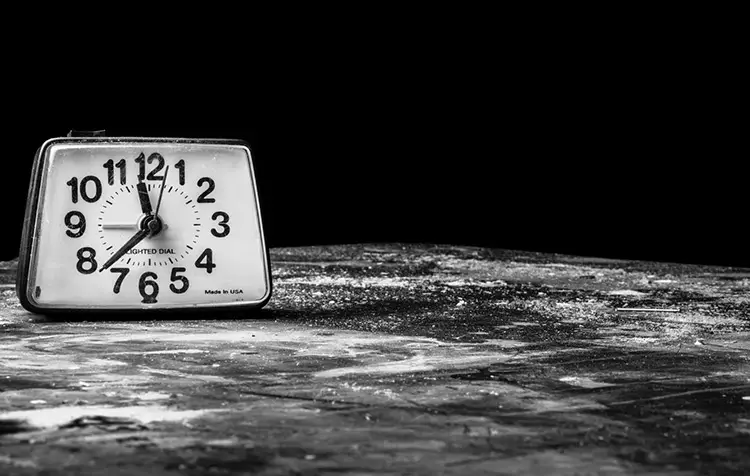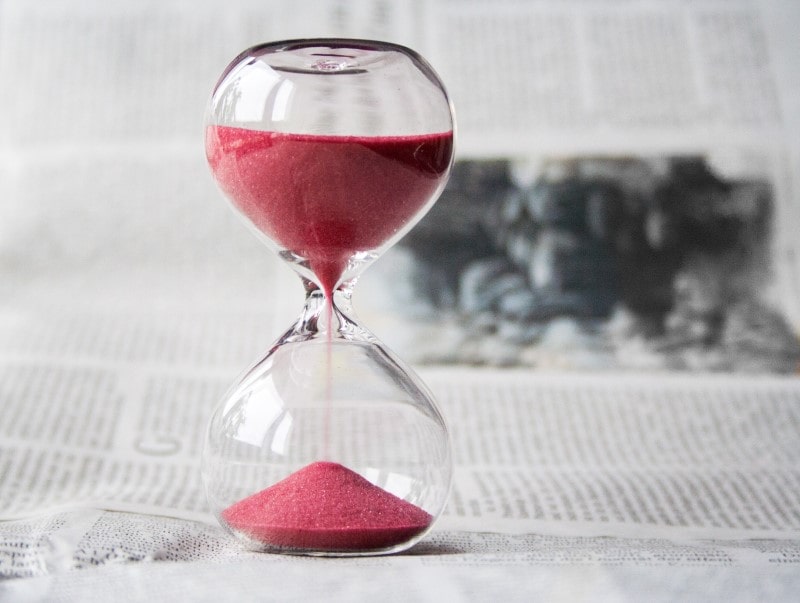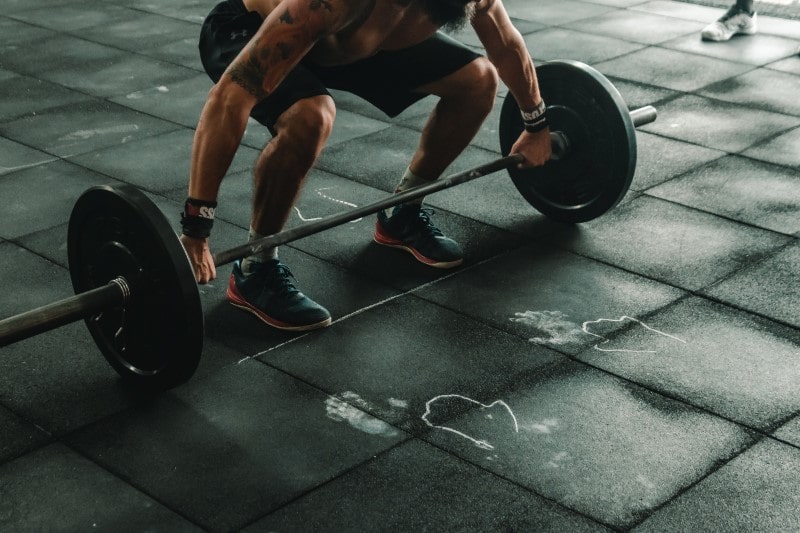What is intermittent fasting? How does intermittent fasting work and what are the benefits?
These and other questions I would like to clarify with you in this article. You will also learn how intermittent fasting affects muscle building, whether it involves risks and what you can eat during the fasting phase. Intermittent fasting is a now relatively well-known fasting concept that has gained a lot of attention, especially in the fitness field. What exactly is intermittent fasting, how it works, what you need to keep in mind and my personal experience with intermittent fasting, I show you in the following article.
Here is another short Table of contents about the article:
What is intermittent fasting?
First, let me explain to you what intermittent fasting is in the first place.
Food and fasting
Intermittent fasting is a special form of diet. You divide the day into two phases, an eating phase and a fasting phase. During the eating phase you can eat and drink anything you want. During the fasting phase you should only Drink water.
What you eat during the eating phase doesn't have to be any different at all from what you normally eat. The only change is that you eat in a certain time window.
Concept from prehistoric times
In principle, the concept corresponds to the food supply from prehistoric times. After all, our ancestors did not yet have supermarkets and ubiquitous food. The food abundance we now experience in Western countries has only existed since the last century.
Our ancestors, who were hunter-gatherers, had to live without solid food for entire days in some places. Only when man began to practice agriculture and animal husbandry was food available at regular intervals. As a result, food intake for our ancestors was always limited in time and divided into eating and fasting phases.
This time limit is also used in intermittent fasting.
Familiarization with intermittent fasting
In the first three days, my stomach grumbled a little in the morning, but you can stand it (see tips). After this time, my body adjusted very quickly to the new time. All in all, you should give your body a test phase of about 14 days, after which you can already assess whether you feel good with intermittent fasting or not.
What can you eat during the fasting phase?
During the fasting phase of intermittent fasting, you should really only drink water. If you are not quite so strict, then you can have any drinks that have no/barely any calories. This means that you can then drink coffee or tea during intermittent fasting.
Personally, I have no experience with tea and coffee in the fasting phase, since I do not drink coffee and it is quite easy for me to do without tea. However, it should be said that tea and coffee must be metabolized in any case and you thus - even if only slightly - break the fast. However, there is no empirical data regarding the exact effects.
So if you don't want to give up coffee and tea during intermittent fasting, that's okay. However, you should definitely avoid sugar or milk, as they contain significant calories. As a basic tip for counting calories in everyday life, you should definitely use a calorie calculator. There are so many of them online. With good calculators, you can calculate your approximate calorie consumption throughout the day. Whether it's for climbing stairs, CyclingWhether it's sitting in the office or playing billiards, you'll find out exactly how many calories are burned in relation to the duration of the activity and your weight.
If you are training on an empty stomach, intermittent fasting allows you to consume about 10 grams of BCAAs 10-15 minutes before training, which is beneficial for your recovery.
How does intermittent fasting work?
16/8 - the Leangains method
Probably the best known form of intermittent fasting is the Leangains method, or 16/8 fasting. Here you have a food window of eight hours and fast the following 16 hours.
I would say the 16/8 method is a very good introduction to intermittent fasting. Eight hours of eating is not that far from the way you normally eat. For example, you can just skip your breakfast, have lunch at 12:00 and dinner at 8:00. In between, you can have a snack and some snacks as you like.
You can also find out more about the 16/8 method on the Leangains website.
I myself have been doing 16/8 for over half a year now and feel great on it. Currently, I am slowly switching to the Warrior diet.
20/4 - the Warrior diet
The Warrior diet or 20/4 fasting has a four hour eating phase and a 20 hour fasting phase. For myself, the Warrior diet is the next step in intermittent fasting that I would like to try.
The 20/4 fasting should not be tried from 0 to 100, but should be approached slowly, as it represents a relatively large change to conventional diets. It's best to start with 16/8 and then gradually work your way up to 20/4.
With sufficient planning, it is even possible to eat only once a day. That would be 23/1.
The Warrior diet or even 23/1 fasting are of course severe restrictions in food intake and therefore you should already be a bit familiar with Food know your way around. Nutrition trackers or calorie counters can be good tools to help with diet planning.
6/1 fasting
The 6/1 fast always refers to a whole week. You eat normally for six days and one day you abstain completely from food. This can look, for example, so that you always fast on Mondays.
In this case, you would then eat dinner normally on Sunday and then not eat anything during the day on Monday. Monday evening you can then eat dinner again normally, so that you have fasted for a total of about 24 hours.
The rest of the week you eat completely normal as usual.
5/1/1 fasting
5/1/1 fasting also refers to a whole week. Here you eat, for example, five days healthy or five days vegan, have a cheat day on which you eat what and when you want and on one day you eat nothing at all.
Alternatively, of course, you can do 16/8 fasting for 5 days, eat what you want and when you want on the cheat day, and eat nothing on the last day, just like 6/1 fasting.
Especially at the beginning you will find the fasting forms, where you do without food for 24 hours, rather difficult. Therefore, I would recommend that you first start with 16/8 fasting and then later also include longer fasting phases.
Other fasting forms
Of course, you can also use 18/6, that is, fast 18 hours and eat six hours. Or 17/7, 19/5 or 21/3. In principle, there are no exact limits here. You can also combine daily fasting phases with an all-day fast.
Good is what feels good to you and what you can manage well in everyday life.
Advantages of intermittent fasting
More muscles through fasting - is that possible?
Increased protein biosynthesis through larger meals
The body uses leucine, an essential amino acid, as an indicator of the quantities of Protein. If sufficient leucine is added, the body therefore assumes that sufficient protein is also supplied and thus starts protein biosynthesis.
According to studies, especially older people react positively to high amounts of leucine. For younger people, an approximate amount of 2 grams of leucine is sufficient. However, this may vary depending on body weight and susceptibility. Young participants in the study were between 28-30 years old, and the older participants were 66 years old. Unfortunately, I did not find any data in between.
By eating larger meals during intermittent fasting, you also increase the amount of leucine consumed per meal and thus stimulate protein biosynthesis. If you specifically eat the largest meal of the day after a workout, you can improve the effect even more.
Of course, it is not enough to take only leucine, because the body needs all essential amino acids and also protein, but leucine is something like the switch that activates protein biosynthesis.
Finally, I want to add that only good nutrition and leucine intake will not make your muscles grow. Proper training and appropriate recovery are other important components for muscle building.
Increase of the growth hormone HGH through fasting
Human growth hormone (HGH) is a natural growth hormone produced in the human body in the alpha cells of the Anterior pituitary is formed. HGH affects bones, muscles and fat cells in adulthood.
The production of HGH can be stimulated and thus increased by physical activity and fasting. According to studies, men can increase the production of the hormone by up to 2000 percent through 24-hour fasting, while women can only increase it by up to 1300 percent.
Sufficient amounts of HGH increase bone density, improve the burning of fat in stored fat cells, and cause an improvement in protein biosynthesis.
The reason for the increased HGH production is the lower insulin level due to fasting. Insulin and HGH work directly against each other. Insulin stores energy absorbed by the body. HGH consumes stored energy to achieve muscle cell growth.
Better digestion
It is better for your digestive tract if you observe longer fasting phases, as your intestines get time to "take care of themselves" here. During the fasting phase, metabolism and intestines come to rest. This also has a supportive effect during colon cleanses, for example.
Intermittent fasting restores your intestines to the natural rhythm to which humans were accustomed for thousands of years when they were hunter-gatherers.
However, the larger meals can be a disadvantage for your digestion. The body must first get used to this and it can also happen in the long term that you do not digest all foods optimally.
Higher concentration and performance
Because your body has to spend less energy on digestion, you have an increased concentration and performance during the fasting phase. In my opinion, this is one of the biggest advantages of intermittent fasting.
Since fasting is mostly done in the morning, you increase your productivity during working hours and can accomplish more in the same amount of time.
Facilitates calorie deficit
Time limits make it easier for many people to reach a calorie deficit. This means that you consume more calories than you take in. If you want to lose weight, it can be useful to reach a calorie deficit for a certain time.
But at the same time, with intermittent fasting, you can stay in a calorie surplus if you eat enough. I don't count calories myself, but I would always say that I am in a calorie surplus. I would also recommend a calorie surplus in general, especially if you want to build muscle.
I recommend a calorie deficit only to a limited extent and if, then only for a certain time. After that, you should come back to the calorie surplus quite normally step by step.
The beauty of intermittent fasting is that it allows you to have both a calorie surplus and a calorie deficit.
Energy generation through fat burning
During the fasting phase, the body draws on fat reserves. It takes about 12 hours for your body to use the energy from your last meal. That means in the remaining hours your body must gain energy by burning fat.
Therefore, intermittent fasting is recommended for weight loss.
Natural "withdrawal" from food addiction
Many people are addicted to sugar or other foods to a certain extent. By limiting your food intake over time, it's easier for you to give up food for a period of time. This way you can also wean your body off sugar.
Time
I myself save time because, on balance, I think less about food and eat less often.
This can be different in the beginning because you have to "plan food" more. However, once you get used to the phases of intermittent fasting, you hardly plan at all.
More advantages
Other benefits of intermittent fasting may include:
- Skin improvement
- Improvement of bone strength and density
- Elimination of erectile dysfunction
- Better mood
However, I have not found much evidence of these benefits. I have also not noticed any changes in myself in this regard. I have never measured my bone density and can therefore not recognize any change in this regard. My skin has always been good, erectile dysfunction has never occurred and the mood is difficult to measure.
Intermittent fasting and strength training
Probably one of the most exciting questions in the field of intermittent fasting and strength training is: When should I train and when should I eat? There are different models for this and of course it always depends on exactly which fasting form you use.
In general, it can be said that the largest meal should be taken after the workout. The meal should be between 35-40% of daily calories. On rest days, the first meal should be the largest.
If you train on an empty stomach, it is recommended to take 10 grams of BCAAs or EAAS before training to optimize metabolism and recovery.
But now to possible forms of the daily routine.
Intermittent fasting plan in 16/8 fasting when training in the evening
- 12:00 p.m. first meal, e.g. cereal/end of fasting phase
- 13:00-14:00 at this time it is good to have one or two snacks between meals
- 15:00 Second meal, e.g. a rather light lunch.
- 16:45 10 grams BCAAs
- 17:00 Workout
- 19:00 Dinner, largest meal
- 20:00 Protein shake/start of fasting phase
This model is particularly suitable for people who have a classic workday until about 5 pm and then go to work out. The number of snacks in between is variable.
This is roughly what your day can look like with intermittent fasting. During the first few hours of work you are in a high state of concentration and performance, then eat the first two meals
Intermittent fasting plan in 16/8 fasting with fasted workout
- 11:45 10 grams BCAAs
- 12:00 Workout
- 13:30 biggest meal
- 16:00 Second meal
- 19:00 Third meal
- 20:00 Protein shake
Of course, this model is less suitable for people with normal working hours. However, it is a good option for the weekend, especially since fasted training is an interesting variant and can also lead to slightly better performance.
In this model, you can always include snacks after the workout. Here you are totally flexible.
Intermittent fasting plan in 20/4 fasting with training between meals
- 13:00 Small meal, for example, a cereal or fruit.
- 15:15 10 grams BCAAs
- 15:30 Workout
- 17:00 biggest meal and protein shake
This model is for people with relatively flexible working hours or shift workers on late or night shifts.
Intermittent fasting plan in 20/4 fasting with fasted workout
- 12:00 Workout
- 13:30 biggest meal
- 15:00 Snack
- 17:00 Second meal
- 17:30 Protein shake
This model differs from the model mainly in the timing of the workout. Here you also need relatively flexible working hours or should work in a shift model. Of course, the model is also suitable for the weekend or other days off.
Common mistakes in intermittent fasting
During intermittent fasting, mistakes can happen. Here are a few typical mistakes you can avoid right from the start.
Not drinking enough water
Drinking water, of course, has the main function in intermittent fasting (as it does elsewhere) to hydrate your body.
Furthermore, you can reduce the feeling of hunger with sparkling water. If you get hungry a few hours before the end of the fasting phase, you can simply drink relatively large amounts of water and thus regulate the feeling of hunger.
In addition, fasting can have a detox effect. To support detox processes should always be drink a lot of waterThis helps to eliminate the toxins that have been released. If you want to support this even more, you can additionally still Chlorella powder supplement. Chlorella binds toxins and thus drains them.
Too few calories
The body needs sufficient macro- and micronutrients, which you must now consume within your eating phase. Before, you had more time to do this. This is one of the risks of intermittent fasting.
If you stick strictly to the phases without paying attention to what you actually are, it can happen that nutrients are missing. Of course, this can also happen with a normal diet and simply depends on what you eat.
On the other hand, of course, you stuff fewer things into yourself unnecessarily. In any case, you should eat your food consciously and make sure that you eat enough.
Caution: calories alone do not count, the food must have a high nutrient density, that is, have a high nutrient content.
Personally, I never count calories, but I make sure that I eat enough and, of course, I make sure that I eat healthy foods.
Of course, a high calorie intake makes the fasting phase easier for you, especially at the beginning. Especially when you really "dig in" at the last meal.
Vary too much with fasting times
You should keep the fasting times as consistently as possible and not push them back and forth too much. For me personally, it works very well when I shift a maximum of one hour forward or backward. On weekends it can also happen that I shift the phases by two hours, but that should be the rarity.
This way you can help your body to get into a fixed rhythm. I notice with myself that it does me good if I stay in rhythm as much as possible. From time to time I also fast longer, as long as it feels good. For example, when I'm busy and could actually eat, but I'm not hungry yet and feel good. However, as soon as hunger comes, I eat.
Risks associated with intermittent fasting
There are not many risks with intermittent fasting. Of course, it can happen to you, especially at the beginning, that you eat a little too little or are hungry. But this has no serious consequences.
During Ramadan, Muslims also abstain from water during the day. This could be problematic because, on the one hand, the body's hydration suffers as a result and because the water satisfies the feeling of hunger from time to time. Muslims observe their own form of intermittent fasting during Ramadan anyway.
It can happen that, depending on how much you eat, the meals are a bit big for your digestion and therefore you do not digest all the food optimally. In this case, adjust the size of your meals a bit by including more snacks and also get a lot of calories from smoothies, since they are easy to digest.
My best tips for intermittent fasting
In this chapter, I want to give you my best tips for intermittent fasting. The following tips are based on my personal experience:
Eat much
During the eating phase you should eat a lot to make the fasting phase easier, especially at the beginning. However, you get used to fasting relatively quickly and the body adapts.
The number of meals you eat during the meal period doesn't matter in and of itself, but what is important is that you make sure you have enough.
Eat carbohydrates
Many still think that carbohydrates make you fat and high carb is bad. To lose weight, high carb is probably not optimal. But for everything else, I can only recommend high carb. Carbohydrates are an easily accessible source of energy for your body, which you need to master your everyday life, your work and your workouts.
Rice and lentils each have very complementary amino acid profiles. Just cook both and mix them together. In addition, both contain relatively high protein and are very filling. Thus, rice and lentils are a must on the diet plan during intermittent fasting.
Eat healthy
Of course, the biggest effect comes from eating as clean as possible. Try to leave out alcohol or at least reduce it. You should also avoid refined sugar and dairy products as much as possible.
You can find tips for healthy breakfast in my Buckwheat muesli contribution or the Recipe contribution to the buckwheat breakfast porridge.
Time your workout
You should never workout right after a meal because the body needs more energy to digest the larger meals. Right after a meal, you simply don't have the energy to really power through your workout and perform at your best.
Stay flexible
For many, this seems way too complicated now, but you don't always have to strictly adhere to it. I, for example, cheat from time to time on vacation or when I am invited to birthdays or family celebrations. Sometimes I just shift my rhythm back a bit and make up for it within the next few days.
Especially in the beginning, I really always started eating at exactly 11:00 and stopped at 19:00. However, intermittent fasting doesn't have to be done to the minute. You shouldn't go crazy like I did in the beginning. Just take it easy and have fun with it.
Use apps
With the app "Zero"you can track your eating phases. It helps you to stick to your times. Zero is suitable for the Leangains method, i.e. 16/8 fasting, but you can also do custom tracking.
You can also use calorie counters or nutrient trackers to keep track of your calories or nutrients.
For example, with the app "MyFitnessPal"You can easily keep a food diary, count your calories and check nutritional values. The database of the app is very large and another advantage is the possibility to combine it with other fitness apps, such as runtastic.
Conclusion about intermittent fasting
One of my experiences with intermittent fasting is that it's important to listen to your body. That has really worked for me. For me, what feels good is always good. Sometimes I fast for an hour longer because I'm just not hungry yet and I feel great right now.
Intermittent fasting is not a miracle cure, so if you still eat poorly and eat through the entire eight hours, you won't get much better results with it than you did before. However, by limiting the time, you set yourself limits, which helped me, for example, to snack less. I often had a snack in the evening and now I simply "forbid" myself to do so. It's that easy to manipulate yourself.
I feel much better or more awake and fit with intermittent fasting. Especially the increased energy and higher ability to concentrate during the fasting phase is a big advantage of intermittent fasting for me. I can be very productive during this time and get more done than I would otherwise. This is one of the biggest advantages of intermittent fasting for me.
If you've never heard of intermittent fasting, it's definitely worth a try.
All the best,

P.S.: Subjecting oneself to self-imposed discipline is the surest way to improve the quality of one's existence.
P.P.S.: If you already have experiences with intermittent fasting, just write them in the comments! You kansnt also times in my post to Chickpeas stop by and learn why these are so healthy. You might also be interested in our post on the Cold training, so you can brave the cold in the winter.










Hey Julian, cool post! I'm still in the initial phase of interval fasting, because I want to focus completely on my diet. That's why I'm going slow with my muscle building - but I'm going jogging more often again and train with light weights. So far I can only say positive things about interval fasting, I eat at noon from 12 always a protein porridge, in the afternoon usually a lot of protein and in the evening then again more proteins with carbohydrates. Best regards!
I think this is a good idea
Hello Julian,
I have a question about BCAAs. I read that BCAAs break the fasting phase. So isn't it more sensible (I train mostly at 05:30 in the morning before work) to do without them to stay fasted and force the body to generate the energy from the fat cells and thus achieve a higher fat burning? By training hard (higher weight, no more than 12 reps, more like 4-8) you give the body the stimuli that it should not break down the muscles and use proteins for muscle building.
How do you see it?
With kind regards
Garry West
PS: Super post, I devoured it!
Hi Garry,
thank you for the praise. As far as I know, it is basically harmless for fasting as long as you stay under 40 kcal. That should be the case with a serving of BCAAs, but take a look at the package. BCAAs are not about gaining energy, but to supply the muscles with nutrients before training. Personally, I would recommend the use of EAAs in the meantime.
The repetition range 4-8 is already relatively broad. I would say 4-6 reps are aimed at increasing strength, 8-12 are in the hypertrophy range and then you get into the strength endurance range. In principle, all three areas have their raison d'être and I wouldn't say that one area is more important than the other. I recommend that you read up on the subject of periodization. Explaining everything here would go beyond the scope of this article 🙂
Best regards
Julian
Comments are closed.